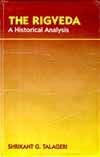Section I : The Rigveda
| 1. The AnukramaNIs |
|
 The AnukramaNIs or Indices of the Rigveda provide us with the most basic information about each of the 1028 hymns of the Rigveda.
The AnukramaNIs or Indices of the Rigveda provide us with the most basic information about each of the 1028 hymns of the Rigveda.
|
| [ More... ] |
| 2. The Composers Of The Rigveda |
|
 The composers of the Rigveda are divided into ten families. These ten families are identified on the basis of the fact that each family has its own AprI-sUkta. An AprI-sUkta is a particular type of ritual hymn “consisting of invocations to a series of deified objects, and said to be introductory to the animal sacrifice”.
The composers of the Rigveda are divided into ten families. These ten families are identified on the basis of the fact that each family has its own AprI-sUkta. An AprI-sUkta is a particular type of ritual hymn “consisting of invocations to a series of deified objects, and said to be introductory to the animal sacrifice”.
|
| [ More... ] |
| 3. The Chronology of the Rigveda |
|
 The first step in any historical analysis of the Rigveda is the establishment of the internal chronology of the text. The Rigveda consists of ten MaNDalas or Books. And, excepting likely interpolations, these MaNDalas represent different epochs of history.
The first step in any historical analysis of the Rigveda is the establishment of the internal chronology of the text. The Rigveda consists of ten MaNDalas or Books. And, excepting likely interpolations, these MaNDalas represent different epochs of history.
|
| [ More... ] |
| 4. The Geography of the Rigveda |
|
 The internal chronology of the Rigveda being firmly established, the next step in our historical analysis of the Rigveda is the establishment of the geography of the text. The geography of the Rigveda has been the most misrepresented aspect of the text in the hands of the scholars ....
The internal chronology of the Rigveda being firmly established, the next step in our historical analysis of the Rigveda is the establishment of the geography of the text. The geography of the Rigveda has been the most misrepresented aspect of the text in the hands of the scholars ....
|
| [ More... ] |
| 5. The Historical Identity of the Vedic Aryans |
|
 We have examined the chronology and geography of the Rigveda, and seen the expansion of the Vedic Aryans from their original, homeland in the east to the west and northwest. But a basic question that remains is: who exactly were these Vedic Aryans and what was their historical identity?
We have examined the chronology and geography of the Rigveda, and seen the expansion of the Vedic Aryans from their original, homeland in the east to the west and northwest. But a basic question that remains is: who exactly were these Vedic Aryans and what was their historical identity?
|
| [ More... ] |
|
Copyright © by Hindu Books Universe All Right Reserved. Published on: 2003-06-28 (2015 reads) [ Go Back ] |